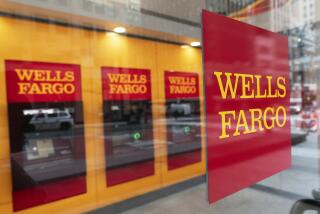Judge approves $142-million class-action settlement in Wells Fargo sham accounts scandal
- Share via
Wells Fargo & Co. has received preliminary approval for its proposed $142-million class-action settlement to compensate possibly millions of customers who had unauthorized accounts opened in their name.
On Saturday, a federal judge in San Francisco found that the proposed settlement was “fair, reasonable and adequate.”
The decision means that the plaintiffs in the class-action suit will soon receive information regarding how to submit claims for settlement benefits. A hearing to decide final approval of the deal has been set for Jan. 4.
“The settlement is an important component of holding Wells Fargo accountable for its abuse of its customers’ trust,” Derek Loeser, partner at Keller Rohrback and lead attorney for the plaintiffs, said in a statement Sunday.
Wells Fargo Chief Executive Tim Sloan said in a separate statement that the preliminary approval represents “a major milestone in our efforts to make things right for our customers.”
The bank said that it will send notices about the process for making claims to current and former customers in the next three months, but any payments will be made after final court approval.
Wells Fargo said it expects the settlement in the case — Jabbari, et al vs. Wells Fargo & Co. — to resolve “substantially all” claims in 10 other pending class actions that allege the unauthorized opening of accounts.
In September, the bank agreed to pay regulators $185 million after it was accused of creating some 2.1 million unauthorized checking and savings accounts, credits cards, and lines of credit without customer approval.
The scandal rocked the San Francisco financial institution and led to the resignation of CEO John Stumpf in October.
The class-action settlement will cover customers who had unauthorized accounts opened beginning May 1, 2002. Customers will be compensated for the fees they were charged based on the number of unauthorized accounts.
One of the major hurdles in reaching a settlement has been determining how many customers were affected by the bank’s practices.
The original terms of the settlement would have provided compensation of $110 million based on regulators original estimates that the bank created as many as 2.1 million unauthorized accounts.
But in April the banked agreed to sweeten the deal to $142 million after an internal investigation found that executives first noticed the problems of unauthorized accounts in 2002.
That prompted plaintiffs attorneys to up their estimates of unauthorized accounts to as many as 3.5 million, though the number of actual customers affected would be less because some customers had multiple accounts.
The two sides also have had to determine how to compensate customers whose credit was damaged by unauthorized credit card accounts. They will qualify for a payout based on a formula that takes into account any loans they took out while their credit score was impaired.
The Los Angeles Times first reported on the sales practice in a 2013 investigation that revealed a relentless sales culture that pressured employees to open unneeded accounts in order to meet quotas.
More to Read
Inside the business of entertainment
The Wide Shot brings you news, analysis and insights on everything from streaming wars to production — and what it all means for the future.
You may occasionally receive promotional content from the Los Angeles Times.











